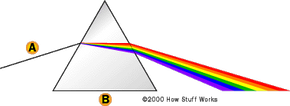Characteristics of Light
As light travels its path, through space, it often encounters matter in one form or another. We should all be familiar with reflection since we see bright reflections when a light hits a smooth shiny surface like a mirror. This is an example of light interacting with matter in a certain way. When light travels from one medium to another, the light bends. This is called refraction. If the medium, in the path of the light, bends the light or blocks certain frequencies of it, we can see separate colors. A rainbow, for example, occurs when the sun's light becomes separated by moisture in the air. The moisture bends the light, thus separating the frequencies and allowing us to see the unique colors of the light spectrum. Prisms also provide this effect. When light hits a prism at certain angles, the light will refract (bend), causing it to be separated into its individual frequencies. This effect occurs because of the shape of the prism and the angle of the light.


If you look closely at what happens as the light wave enters the prism in the second diagram, you will notice that it bends down. This bending occurs because the light travels faster through the air than it does through the prism. When the lower portion of the wave enters the prism, it slows down. Since the upper portion of the wave (still in the air) is traveling faster than the lower portion, the wave bends. Similarly, as the wave exits the prism, the upper portion exits first and begins travelling faster than the lower portion that is still in the prism. This speed differential causes the wave to bend once again. Think of a skateboard rider going down the driveway. If the rider turns and goes into the grass, his body will lunge forward and actually fly off of the board if he is traveling fast enough originally. This is analogous to light bending as it goes through different mediums. The skateboard and the rider are moving at the same speed until the wheels hit the grass. Now suddenly, the skateboard is traveling slower than the rider is, so the rider begins to bend forward (the rider is trying to continue traveling at the same speed he was before the wheels hit the grass).
Advertisement
Now that we have a little understanding of the composition of light, we can begin to resolve the oft under explained concept of "the speed of light". Since light itself is just a form of electromagnetic radiation, the speed of light is just an easy way of talking about the speed of electromagnetic radiation in general. If you think about it, the speed of light is the "speed of information". We can not acknowledge that an event has occurred until the information about that event reaches us. The information is contained in the electromagnetic radiation from the event via a radio signal, a flash of light etc. Any event is just an occurrence of space and time, and any information that can be transmitted about an event is emitted outward as radiation of some sort. The information (electromagnetic radiation) from the event travels at 186,000 miles/second in a vacuum. If you picture a long train that begins to move forward from a stopped position, you do not expect the very last car to begin moving instantaneously. There is an amount of time that passes before the last car begins to get pulled. Thus, there is an expected delay for last car to "receive" the information that the first car is moving and pulling. This delay is analogous to the transfer of information in special relativity, but SR only imposes an upper limit on the speed of the information; the speed of light. You can make the train example as detailed as you like, but regardless, you will always find that there can be no reaction without a time delay of at least the speed of light between the action and reaction. In the special relativity section we will further discuss the importance of this speed.
